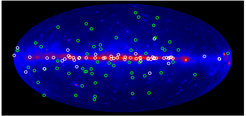γ-Ray Pulsars

Map of the γ-ray sky (in Galactic coordinates) as seen by FERMI LAT. Green circle represent the positions of 57 millisecond pulsars, where were discovered in previously unidentified LAT point sources. White circles mark the positions of 56 γ-ray pulsars, which were found in blind searches conducted at γ-rays alone. The Kramer Division was involved in a significant or even leading position in these efforts.
© MPIfR, Jason Wu
The launch of the Fermi Gamma-ray Space Telescope has been one of the major developments in pulsar science in the last few years. Previously, only seven pulsars were known to emit γ-rays, but with the Large Area Telescope on board Fermi we now know many more. Here is an updated list with more than 100 pulsars! This great success has in part been possible because of the symbiotic collaboration between radio and γ-ray astronomers:
- A first step we timed radio pulsars that were suspected of having strong γ-ray emission. After the launch of Fermi, many of these were confirmed as γ-ray pulsars; a task made much easier by the availability of radio ephemerides. Fermi also discovered that several millisecond pulsars are γ-ray emitters! Even millisecond pulsars in globular clusters are now appearing as γ-ray pulsars.
- In a second phase, many new γ-ray pulsars are being found from their γ-ray emission alone! Most of these have not been detected at radio wavelengths, but some were: here e.g. the detection of the faintest young radio pulsar known.
- In a third phase, many Fermi sources that had low variability and sharp cutoffs in the spectra (characteristics of γ-ray pulsars) could be so well localized in space that we could use radio telescopes to search efficiently for radio pulsars in these sources. Many of them are now revealing new pulsars. Most of these are millisecond pulsars, and most of those are in binary systems, which explains why their pulsations could not be detected in γ-rays. After deriving a radio timing ephemeris, we can see their γ-ray pulses.
As a result of these searches, we know a lot more about the population of neutron stars in the Galaxy and about the mechanism of γ-ray emission. No doubt many more γ-ray pulsars remain to be found by the Fermi LAT!
